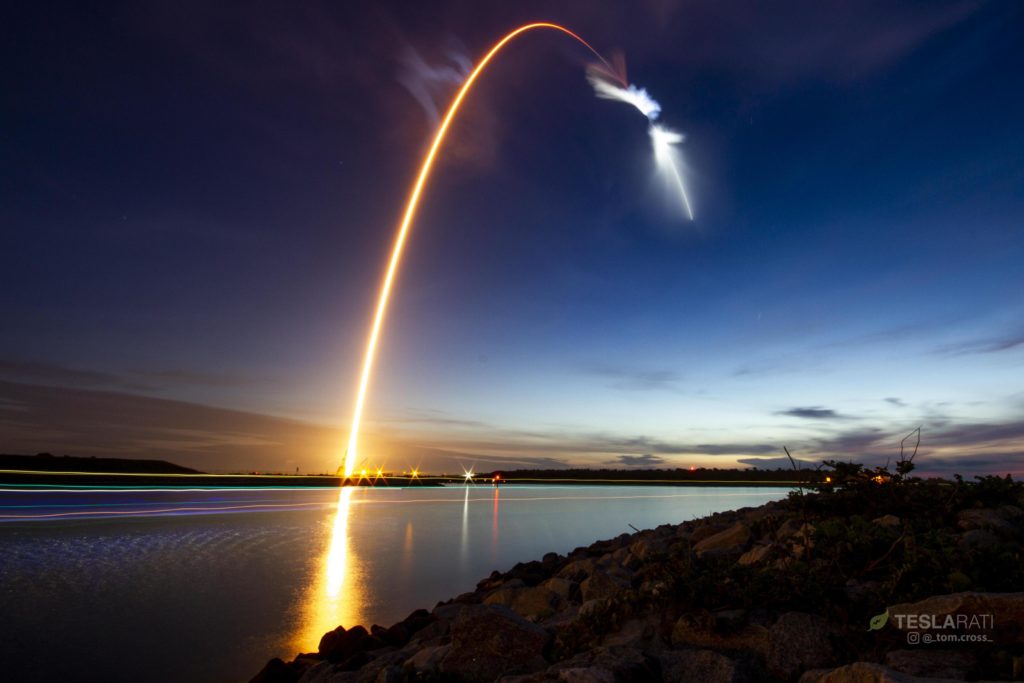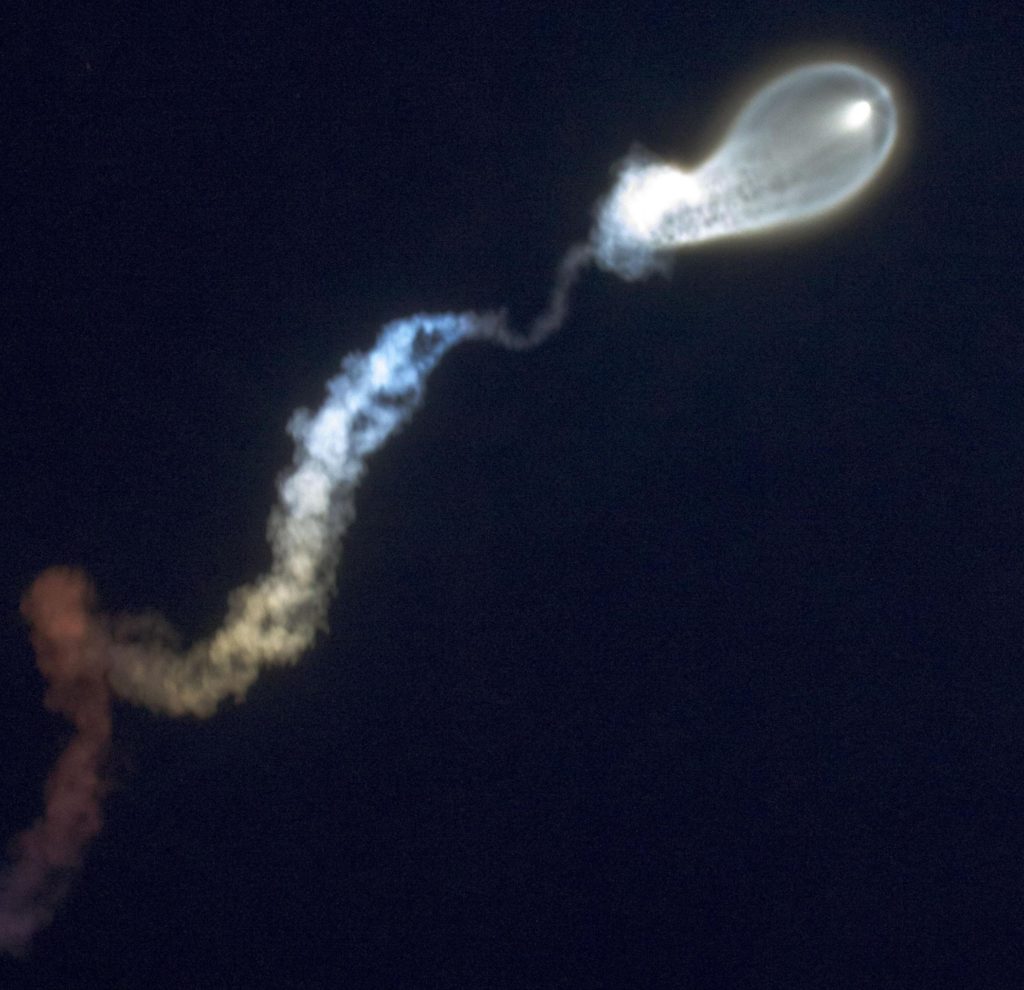

News
SpaceX bids goodbye to older Falcon 9s with Florida ‘jellyfish’ launch spectacle
SpaceX’s final Block 4 Falcon 9 has completed its second and last orbital mission with a spectacular sendoff visible for hundreds of miles along the East Coast, harkening back to “alien invasion” comparisons that followed an equally stunning SpaceX launch from California last December.
Although the Falcon 9 booster was expended in the Atlantic Ocean minutes after launch, its upper stage remains in orbit in an experimental test of its lifespan, while the mission’s flight-proven Cargo Dragon spacecraft separated from the rocket and headed to the International Space Station with a promise of a possible third orbital reuse in 2019. This mission’s Dragon capsule flew for the first time in late 2016 for the CRS-9 mission and spent the two years since then having its heat shield and other major components refurbished or replaced, likely at a cost to SpaceX less than half that of constructing a brand-new Dragon spacecraft.

Falcon 9 B1045 lounges in the Florida summer humidity, hours before its second and final launch. (Tom Cross)
According to Jessica Jensen, SpaceX’s Director of Dragon Mission Management, SpaceX’s Dragon refurbishment team has also gotten considerably more efficient over several years of experience reusing the orbital spacecraft, now up to three reflights of three separate capsules. She noted in the postlaunch conference that – if all major components are healthy upon CRS-15’s early-August return to Earth – this capsule could be refurbished for its third mission in as few as months, which would make it one of the last Dragon 1 launches before the upgraded Dragon 2 begins crewed flights and takes over all cargo missions. After CRS-15, five more of those Cargo Dragon flights remain until CRS-2’s 2020 takeover, all of which will utilize flight-proven capsules.
- CRS-15’s dramatic pre-dawn launch. (Tom Cross)
- The extraordinary plume was lit up by the sun before it had risen above the Eastern horizon. (Tom Cross)
Falcon 9, on the other hand, reached a truly historic milestone today for SpaceX – B1045’s second and final flight marks the last rocket SpaceX will fly that does not feature a number of upgrades designed to dramatically improve booster reusability. Known as Falcon 9 Block 5, all future SpaceX missions (at least until BFR’s debut sometime in the early 2020s) will be launched aboard the upgraded rocket. If it works as intended, Block 5 should theoretically enable a rapid and affordable level of reusability never before achieved by Falcon 9 or any other rocket, for that matter.
https://twitter.com/_TomCross_/status/1012694524987092992
While still more than a little disheartening to see a Falcon 9 booster intentionally expended after launch, the spectacle created by B1045’s final flight was fitting, to say the least. Thankfully, the Block 5 takeover of all future SpaceX Falcon 9 and Falcon Heavy launches is likely to also result in a dramatic reduction in SpaceX’s willingness to expend flight-proven rockets after launch. Whereas Block 3 and 4 Falcon 9s were never designed to affordably and safely fly more than two or three times total, minimizing any opportunity cost from expending twice-flown rockets after launch, Block 5 has been purpose-built to allow individual boosters to fly a bare minimum of 10 times with minimal refurbishment and as many as 100 times with regular maintenance. Unless Block 5’s design fails to achieve that level of reusability, SpaceX is extremely unlikely to expend Block 5 boosters unless they have flown a number of times to extract as much value as possible from them.
Up next on SpaceX’s manifest are two back-to-back Falcon 9 Block 5 launches, Iridium-7 from California on July 20 and Telstar 19V from Florida less than 18 hours later. Both Block 5 boosters will be recovered aboard SpaceX’s fleet of drone ships, Just Read The Instructions (JRTI) to the West and Of Course I Still Love You (OCISLY) to the East.
Follow us for live updates, peeks behind the scenes, and photos from Teslarati’s East and West Coast photographers.
Teslarati – Instagram – Twitter
Tom Cross – Twitter
Pauline Acalin – Twitter
Eric Ralph – Twitter

Elon Musk
Elon Musk’s X will start using a Tesla-like software update strategy
The initiative seems designed to accelerate updates to the social media platform, while maintaining maximum transparency.

Elon Musk’s social media platform X will adopt a Tesla-esque approach to software updates for its algorithm.
The initiative seems designed to accelerate updates to the social media platform, while maintaining maximum transparency.
X’s updates to its updates
As per Musk in a post on X, the social media company will be making a new algorithm to determine what organic and advertising posts are recommended to users. These updates would then be repeated every four weeks.
“We will make the new 𝕏 algorithm, including all code used to determine what organic and advertising posts are recommended to users, open source in 7 days. This will be repeated every 4 weeks, with comprehensive developer notes, to help you understand what changed,” Musk wrote in his post.
The initiative somewhat mirrors Tesla’s over-the-air update model, where vehicle software is regularly refined and pushed to users with detailed release notes. This should allow users to better understand the details of X’s every update and foster a healthy feedback loop for the social media platform.
xAI and X
X, formerly Twitter, has been acquired by Elon Musk’s artificial intelligence startup, xAI last year. Since then, xAI has seen a rapid rise in valuation. Following the company’s the company’s upsized $20 billion Series E funding round, estimates now suggest that xAI is worth tens about $230 to $235 billion. That’s several times larger than Tesla when Elon Musk received his controversial 2018 CEO Performance Award.
As per xAI, the Series E funding round attracted a diverse group of investors, including Valor Equity Partners, Stepstone Group, Fidelity Management & Research Company, Qatar Investment Authority, MGX, and Baron Capital Group, among others. Strategic partners NVIDIA and Cisco Investments also continued support for building the world’s largest GPU clusters.
News
Tesla FSD Supervised wins MotorTrend’s Best Driver Assistance Award
The decision marks a notable reversal for the publication from prior years, with judges citing major real-world improvements that pushed Tesla’s latest FSD software ahead of every competing ADAS system.

Tesla’s Full Self-Driving (Supervised) system has been named the best driver-assistance technology on the market, earning top honors at the 2026 MotorTrend Best Tech Awards.
The decision marks a notable reversal for the publication from prior years, with judges citing major real-world improvements that pushed Tesla’s latest FSD software ahead of every competing ADAS system. And it wasn’t even close.
MotorTrend reverses course
MotorTrend awarded Tesla FSD (Supervised) its 2026 Best Tech Driver Assistance title after extensive testing of the latest v14 software. The publication acknowledged that it had previously criticized earlier versions of FSD for erratic behavior and near-miss incidents, ultimately favoring rivals such as GM’s Super Cruise in earlier evaluations.
According to MotorTrend, the newest iteration of FSD resolved many of those shortcomings. Testers said v14 showed far smoother behavior in complex urban scenarios, including unprotected left turns, traffic circles, emergency vehicles, and dense city streets. While the system still requires constant driver supervision, judges concluded that no other advanced driver-assistance system currently matches its breadth of capability.
Unlike rival systems that rely on combinations of cameras, radar, lidar, and mapped highways, Tesla’s FSD operates using a camera-only approach and is capable of driving on city streets, rural roads, and freeways. MotorTrend stated that pure utility, the ability to handle nearly all road types, ultimately separated FSD from competitors like Ford BlueCruise, GM Super Cruise, and BMW’s Highway Assistant.
High cost and high capability
MotorTrend also addressed FSD’s pricing, which remains significantly higher than rival systems. Tesla currently charges $8,000 for a one-time purchase or $99 per month for a subscription, compared with far lower upfront and subscription costs from other automakers. The publication noted that the premium is justified given FSD’s unmatched scope and continuous software evolution.
Safety remained a central focus of the evaluation. While testers reported collision-free operation over thousands of miles, they noted ongoing concerns around FSD’s configurable driving modes, including options that allow aggressive driving and speeds beyond posted limits. MotorTrend emphasized that, like all Level 2 systems, FSD still depends on a fully attentive human driver at all times.
Despite those caveats, the publication concluded that Tesla’s rapid software progress fundamentally reshaped the competitive landscape. For drivers seeking the most capable hands-on driver-assistance system available today, MotorTrend concluded Tesla FSD (Supervised) now stands alone at the top.
News
Elon Musk’s Grokipedia surges to 5.6M articles, almost 79% of English Wikipedia
The explosive growth marks a major milestone for the AI-powered online encyclopedia, which was launched by Elon Musk’s xAI just months ago.

Elon Musk’s Grokipedia has grown to an impressive 5,615,201 articles as of today, closing in on 79% of the English Wikipedia’s current total of 7,119,376 articles.
The explosive growth marks a major milestone for the AI-powered online encyclopedia, which was launched by Elon Musk’s xAI just months ago. Needless to say, it would only be a matter of time before Grokipedia exceeds English Wikipedia in sheer volume.
Grokipedia’s rapid growth
xAI’s vision for Grokipedia emphasizes neutrality, while Grok’s reasoning capabilities allow for fast drafting and fact-checking. When Elon Musk announced the initiative in late September 2025, he noted that Grokipedia would be an improvement to Wikipedia because it would be designed to avoid bias.
At the time, Musk noted that Grokipedia “is a necessary step towards the xAI goal of understanding the Universe.”
Grokipedia was launched in late October, and while xAI was careful to list it only as Version 0.1 at the time, the online encyclopedia immediately earned praise. Wikipedia co-founder Larry Sanger highlighted the project’s innovative approach, noting how it leverages AI to fill knowledge gaps and enable rapid updates. Netizens also observed how Grokipedia tends to present articles in a more objective manner compared to Wikipedia, which is edited by humans.
Elon Musk’s ambitious plans
With 5,615,201 total articles, Grokipedia has now grown to almost 79% of English Wikipedia’s article base. This is incredibly quick, though Grokipedia remains text-only for now. xAI, for its part, has now updated the online encyclopedia’s iteration to v0.2.
Elon Musk has shared bold ideas for Grokipedia, including sending a record of the entire knowledge base to space as part of xAI’s mission to preserve and expand human understanding. At some point, Musk stated that Grokipedia will be renamed to Encyclopedia Galactica, and it will be sent to the cosmos.
“When Grokipedia is good enough (long way to go), we will change the name to Encyclopedia Galactica. It will be an open source distillation of all knowledge, including audio, images and video. Join xAI to help build the sci-fi version of the Library of Alexandria!” Musk wrote, adding in a later post that “Copies will be etched in stone and sent to the Moon, Mars and beyond. This time, it will not be lost.”










